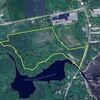Processing Your Payment
Please do not leave this page until complete. This can take a few moments.
Seeking self-reliance | With a track record of controversial proposals and painful business failures, Maine's Indian tribes struggle for economic independence
The mistakes highlight a truth: When it comes to economic development, Maine's Indian tribes ˆ the Penobscot, Passamaquoddy and two tribes in Aroostook County, the Maliseet and the Micmacs ˆ have been stuck in neutral.
Which isn't to say they haven't had big economic development ideas. But those ideas have more often met frustration than success. Take as an example the grandest tribal economic development plan of all: the $650 million casino pitched by the Penobscot and Passamaquoddy, a project they believed would finally pull them out of poverty. But after a bitter campaign, state voters overwhelmingly rejected the casino in 2003, and Maine's Indians are still searching for a way to put their feet on solid economic ground. "The Holy Grail was the casino," says Penobscot state Rep. Michael Sockalexis. "And that didn't happen."
The reservations remain among the state's poorest places, with high unemployment, poverty and rates of disease. They are places where problems can seem insurmountable and economic development can seem elusive. Outside investment is hard to attract, but there's little money locally, and, from the tribe's point of view, state government seems indifferent to their concerns. For decades now, tribes have searched for a formula for economic success. Plans have frequently shifted, but the goal has been the same: self-reliance, an end to dependence on the federal government dole.
Now, differences are emerging in how each tribe chases that goal. The Passamaquoddy, living mostly on two distinct reservations in Washington County, continue to pursue the big project with the big payoff ˆ and big controversy. They recently proposed a racetrack casino for Washington County, an idea that had solid support downeast but stalled in the face of opposition from Augusta politicians, including Gov. John Baldacci, and a failed petition drive. The tribe now turns to a push for a Liquefied Natural Gas terminal on Passamaquoddy Bay ˆ a proposal that may be more contentious than the casino fight, because it even divides the tribe.
The Penobscot, on the other hand, are largely forgoing grand, controversial projects in favor of modest proposals that seem easier to achieve, even if their potential rewards are less dazzling. "We have changed the way we do business," says Penobscot Chief James Sappier.
In an attempt to professionalize economic development, the tribe recently formed a federally chartered corporation ˆ Penobscot Indian Nation Enterprises ˆ expected to operate independently of tribal government. That body will oversee projects on the tribe's economic radar screen, including the up-and-running PIN RX mail-order prescription drug program, a non-tribal housing development planned for the Bangor area, an airplane-repair facility in a hangar at the soon-to-be-shuttered Brunswick Naval Air Station and a soon-to-be announced wind farm proposal for tribal land in western Maine.
The Aroostook County tribes have plans of their own. The Houlton Band of Maliseet is proposing their version of the grand project, a $9 million biodiesel plant for tribal land along Route One, while the Aroostook Band of Micmacs ˆ a 1,000-member tribe with offices in Presque Isle ˆ is closely watching PINE and the Penobscot. They, too, are considering an economic development corporation, says Russell Dennis, the tribe's economic development director. The tribe also is weighing a mail-order pharmaceutical business. "The ultimate goal would be self-sufficiency ˆ that's a goal all the tribes have," Dennis says. "You've got to be able to control your own destiny. We all know what's happening to federal funding. It's not going to be there forever."
Settling for less
Away from Maine, some Indian tribes are making dramatic financial gains. A 2005 study by the Harvard Project on American Indian Economic Development analyzed U.S. Census data and found that tribal per capita income on reservations grew by 33% from 1990 to 2000 ˆ an increase three times that found among the general population. The study ties the gains not to new casinos, but to the rise of something else: the tribal sovereignty increasingly encouraged by the federal government. "The tribes without gaming are growing as fast as the tribes with gaming," says professor Joseph Kalp, a report co-author.
Some tribes have undergone stunning transformations. Nebraska's Winnebago tribe in 1994 formed a corporation, Ho-Chunk Inc., using $8 million in seed money from the tribe's small casino. Ho-Chunk now has $65 million in annual revenue from businesses involved in a bevy of fields, including construction, marketing, housing development, office and computer products, groceries, gasoline, tobacco and native crafts.
That kind of progress remains a dream for Maine's four tribes, 26 years after the Maine Indian Claims Settlement Act was supposed to bring change. The act, which spawned optimism among tribal members wearied by decades of decline, was the resolution of a lawsuit claiming ownership of 12.5 million acres of Maine by the Penobscot, Passamaquoddy and Maliseet. The settlement brought federal recognition to the tribes ˆ and millions of dollars of federal aid that dramatically improved living conditions on the reservations. It also brought $54.5 million for land purchases ˆ which have made the Penobscot and Passamaquoddy among the state's largest landowners ˆ and $27 million to be held in trust. Interest from that trust is delivered in small annual payments to members of the tribes (the Maliseet received $900,000 for land purchases, and did not receive trust money).
In the rosy wake of the settlement, economic success seemed a cinch. The Passamaquoddy bought the Northeast Blueberry Company, a Washington County operation it still profitably owns. Then the tribe purchased Dragon Cement in Thomaston, invested in the facility and sold it in 1988 for a $60 million profit, money still filtering to tribal members today. "That was one of our more successful efforts," says Robert Ritter, director of economic development for the Passamaquoddy at Indian Township. "We'd like to do something like that again."
Nine years after the settlement came a federal law allowing tribal casinos, from which many other tribes have finally achieved prosperity. But the law also exposed a catch in the Maine settlement: It excludes the tribes from federal law changes that do not mention them by name. That exclusion forces the tribes to seek statewide approval for tribal casinos ˆ to wage, as in 2003, divisive and expensive campaigns for a right every tribe in the nation already has.
That the state refuses to put Maine tribes' rights in line with other tribes is a source of deep frustration for members. And the fact that voters in 2003 rejected a tribal casino but approved racetrack slot machines adds salt to the wound. Sappier says he has tried to convince himself residents voted as they did because of the casino's proposed site in crowded and wealthy southern Maine. "I opt to believe that it was location, because I cannot believe that Maine was that racist," he says. "I have a lot of tribal members who believe that it was racism."
Immediately after the casino defeat, leaders from Maine's four tribes met in Augusta with Baldacci, who had angered the tribes by campaigning against the plan. The goal of the meeting, besides smoothing ruffled feathers, was to set an economic development strategy for the tribes. But Barry Dana, the Penobscot chief through the casino fight, says now that the meeting yielded little. "You ever stand behind a plane that's getting ready to take off?" Dana asks. "That's what it amounted to."
As if tribal members needed more convincing that their financial success is not among top state priorities, the Legislature recently rejected giving $200,000 to each tribe's economic development efforts. The money, says Sockalexis, would have been used for feasibility studies, to help avoid mistakes like the Penobscot's long-ago moccasin debacle. "It's very frustrating," he says. "This would have gone a long way to help us."
Stepping over the obstacles
A perceived lack of external support is matched by internal shortcomings in the tribes' finances. The economic development problem faced by Maine's tribes centers on an age-old question: How do you create wealth when you don't have any? In terms of economic development, it's extremely tough," Dana says. "We don't have a cash fund that we can draw on to start businesses."
That truth has forced the tribes to seek private partners for development efforts, yet remote tribal lands usually aren't seen as ripe for investment by outsiders. Still, the problems faced by Maine's tribes are not unique. The Harvard project notes that Indian Country "is dotted with failed projects that turned sour" or "failed to attract customers."
Reservations are among the nation's poorest places, and obstacles to development can be daunting. The project says it's widely believed that tribes lack access to financial capital; lack "human capital" ˆ an educated or entrepreneurial workforce; plan too much while delaying action; are distant from markets and transportation networks; and have unworkable or instable governments that deter investment.
Still, Kelp notes steps tribes can take to advance economic success ˆ steps the Harvard project finds among the wealthiest tribes. First and most important, those tribes divorce economic development from tribal government. Tribal reservations, Kelp says, are often places rife, like small towns everywhere, with personal rivalries that can mire development efforts.
Successful tribes, according to the Harvard project, also streamline government permitting and record keeping; look for an economic niche; find access to financial capital; and exploit natural resources found on tribal lands ˆ all steps that are perhaps easier said than done.
Tribes also have advantages with government contracts, a fact optimistically cited by most tribal leaders interviewed for this story. The Maliseet, for example, have partnered with Bethesda, Md.-based Tribal Co., a non-tribal company that partners with tribes to win contracts. It has helped the tribe get federal contracts for radio equipment services, Maliseet Chief Brenda Commander says, and "huge contracts" are pending. Tribal Co. expects no work from the tribe, Commander says ˆ it handles the jobs itself ˆ but still delivers a portion of profits to Houlton.
The arrangement seems too good to resist, but Kelp warns that the path to true economic development is considerably more challenging. He says too many tribes pin hopes on government contracts. "It's really hit or miss with which tribes have been successful chasing those," Kelp says.
The Maliseet, at least, have other projects planned, none grander than a $9 million biodiesel plant that would turn soybean and canola oil into five million gallons of fuel annually. The tribe expects the plant will employ about 22 people and deliver $1 million annually to its budget. The Maliseet, looking for backing for the environmentally friendly project, tout a glowing outside feasibility study. "I think we're in a position to do something very positive," Commander says. "We wanted to look beyond gambling to something that everybody would support ˆ and biodiesel seemed a good fit."
Of Maine's tribes, the Penobscot are most closely following the model outlined by Kelp. Tim Love, the tribe's economic development advisor, cited the Harvard work as a model for some recent moves ˆ especially PINE, the stand-alone corporation established in December. "More times than not," Love says, "when elected folks make decisions on economic development, they don't work, because they're tainted by political considerations."
Penobscot leaders say they have learned from past mistakes. To ensure the feasibility of current plans, the tribe now insists on help from outside experts. Current development plans are relatively modest ˆ at least when compared to a casino or LNG terminal ˆ and the Penobscot hope to avoid an all-eggs-in-one-basket approach. "We need diverse enterprises," Chief Sappier says. "We have a diverse population with a diverse background."
In Hampden, the tribe is working to build 80 units of affordable housing. High-stakes bingo on Indian Island continues to bring revenue, even with a racino nearby. The PIN RX mail-order pharmaceutical program employs 18, though it is not yet profitable. Then there's a plan for a wind farm in Western Maine, for which an announcement is expected soon. Even with about 25% of members unemployed, Penobscot leaders say the economic development projects they've chosen were not selected to create tribal jobs. "The mission is to try to build wealth for the tribe," Love says.
Finding funding for the projects remains difficult, but Love says the tribe is looking to partner with other tribes rolling in newfound casino wealth, such as the Mashantucket Pequot in Connecticut, owners of Foxwoods, or the Mississippi Choctaw. "We know they're sensitive to where we are," Love says. "They weren't always rich."
A tribe divided
The Passamaquoddy are one tribe divided by Washington County woods and water. About 640 of 1,800 tribal members live at Pleasant Point, a small spit of land near Easport. There, tribal leaders have partnered with Oklahoma-based Quoddy Bay LLC to build a $500 million LNG terminal on reservation land. About 40 miles away, at Indian Township, lies the second group of Passamaquoddy. They, too, have an LNG proposal, a partnership with Pittsfield-based Cianbro for a terminal in Calais.
In economic development efforts, the tribe typically works as one unit. That's how it went for the southern Maine casino and the recently rejected racino, a prospect tribal leaders say they are not done pursuing. "We're continuing to work with the state to try to develop something in Washington County," says Ritter. "There's not many alternatives here for economic development."
But LNG proposals have the tribe competing with itself, reducing the odds either will succeed. The competition seems less than friendly. Ritter says the Pleasant Point branch went ahead with LNG plans without including Indian Township, leaving the latter scrambling. Indian Township leaders are holding up early payments from Quoddy Bay to the Pleasant Point tribe, according to tribal governor Mark Altvater. Those payments depend on approval of tax limitations for Quoddy Bay by the Joint Tribal Council, the governing body for both branches. But the approval has not come; without it, Altvater says, it's unclear whether the LNG terminal even can be built.
The Pleasant Point LNG proposal, in particular, also has critics, including members of the tribe who say a large industrial plant on a small reservation will corrode quality of life there.
Hilda Lewis is an LNG opponent recently elected to the Pleasant Point Tribal Council. Like others who oppose LNG, she accuses Passamaquoddy leaders of continually reaching for grand economic development projects while forgoing smaller projects that require hard work but are more achievable. She believes the tribe should use its most precious asset ˆ its 140,000 acres of land ˆ to build wealth. For example, why not encourage ecotourism? "There are so many other things that we can go into that are not going to bring millions and millions of dollars, but they'll bring some money," Lewis says. "To put an industrial terminal on sacred tribal land goes against my principles."
But others note that Passamaquoddy lands are very remote. If not LNG, what else could push the Passamaquoddy to self-sufficiency? Altvater estimates only 35% of tribal members are employed, and says money from the long ago sale of Dragon Cement is "drying up." Altvater believes LNG will bring jobs to Washington County while giving the tribe an income supply it desperately needs. Ritter, of the Indian Township branch, agrees: "The alternative to big industry is poverty," he says. "And it's not a good alternative."
The goal for all four of Maine's tribes is to end poverty among their members. Just how to do that, however, has been the challenge. And it remains to be seen whether current economic development plans will succeed where previous ventures fell short. "We're stuck in this quagmire of being dependent on the feds," says the Penobscot's Love. "We're sitting outside trying to scratch our way in."










Comments